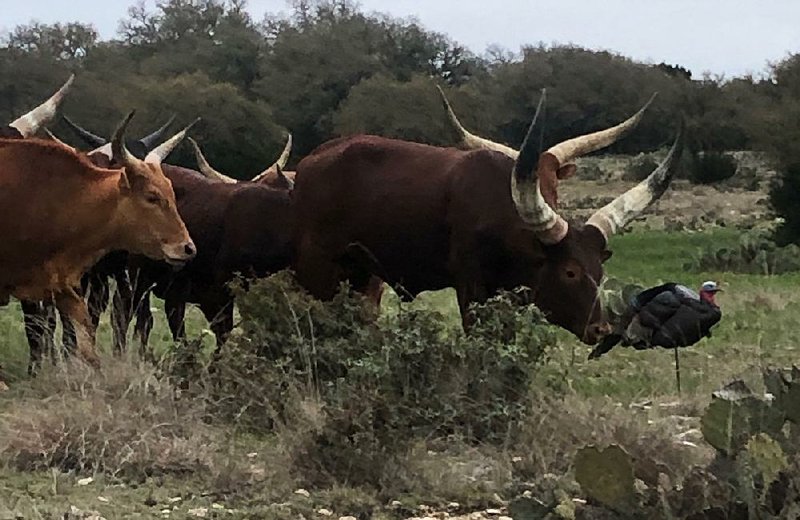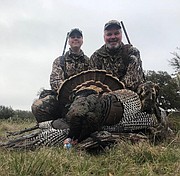John Volpe and Joe Volpe weren't about to let this turkey escape.
Federal magistrate judge Joe Volpe of Little Rock and his son John have been avid turkey hunters since 2016, when John killed his first gobbler in Kansas.
Their first hunt of the 2019 spring turkey season occurred in the Hill Country near Rock Springs, Texas. They hunted with Sky Watkins of Blackwater Guide Service on a ranch that's known for exotic big game animals. It also supports a herd of Watusi cattle, which have some of the largest horns in the bovine universe.
Also present are healthy numbers of Rio Grande wild turkeys. They're an afterthought in the shadows of the big game, but Joe Volpe said Watkins is enthusiastic about them.
Volpe bought a hunting package that entitled him and John to kill two gobblers apiece. Rio Grande turkeys are reputedly easier to hunt than the eastern subspecies that inhabits Arkansas, but the Volpes discovered that mature gobblers are very wily regardless of breed.
"Texas turkeys are so MEAN!" Joe Volpe wrote Tuesday in a text message. "Getting our [backsides] handed to us. Not sure why I chase these things."
"No respectable Arkie ever gets beat by anything Texas," I replied.
With the gauntlet thrown, the Volpes redoubled their efforts in the second half.
A mature gobbler appeared to have set the table for a strong finish the evening before their final hunt. The bird gobbled and strutted 150 yards away from the Volpes all the way to about 7:30 p.m., before flying up to its roost.
If you can roost a bird, you stand a really good chance of bagging him in the morning, but a lot of things can derail your plans. First, it really helps to be near the place where the gobbler likes to display when he leaves the roost. If not, it can be challenging to call him away from that spot.
Also, a real hen can pick off a gobbler and take him away. Worse, a harem of hens might be nearby. It's important to be in the right spot at the beginning and finish the job quickly.
As luck would have it, the Volpe's did not set up the next morning in the gobbler's preferred spot.
Instead, a herd of Watusi cattle converged upon the Volpes, which made them very nervous.
"I was thinking, 'Man, I sure hope these things aren't aggressive,'" Joe Volpe said. "Sky told us later that they certainly can be. Not only that, but he also has some buffalo on the place, and some of these things had mated with the buffalo. The hybrids are super aggressive."
The Watusi took a shine to the Volpes' turkey decoy. They surrounded the decoy and nuzzled and licked it.
Though nearby, the gobbler wanted no part of that scene, and it departed in the other direction.
Disappointed, the Volpes considered their options. The morning hunt was ruined, but you can often call in a gobbler in the midday hours.
With that in mind, the Volpes found an ideal ambush spot. John Volpe had the perfect shooting site, but he was exposed. Joe Volpe was entirely concealed in a place that offered a less satisfactory shot.
"I felt like one of us would get him," Joe Volpe said.
As planned, the gobbler wandered into the crossfire.
"He must have seen John because he spooked," Joe Volpe said. "He started to leave, but we both shot at exactly the same time. He didn't have a chance. It was so cool!"
The 3-year old gobbler weighed 22 pounds. Its beard was 101/2 inches, and its spurs were 3/4-inch.
Time expired with just the one bird in the bag. Watkins invited them to another ranch to complete their package at no extra charge.
"I thought that was really cool of him to do that," Joe Volpe said, "but with everything going on back home, I don't think we'll have the time."
Meanwhile in Arkansas, several turkey hunters are anxiously awaiting the opening of our own spring turkey hunting season on April 8.
Mike Stanley of Highland texted me a photo from an undisclosed location in Fulton County. It showed 11 turkeys, including one very large gobbler and three subordinates, at the edge of a pasture.
Another photo taken in Baxter County showed a large flock of turkeys again in a pasture.
"My landowner took these a few minutes ago when he was checking cows," Stanley wrote in a text. "He watched the dominant gobbler breed two different hens."
The turkeys I hunt in the Gulf Coastal Plain exhibit a peculiar characteristic. They seldom gobble. Early in March and April mornings in Missouri and Oklahoma, gobblers thunder from their roosts at dawn. You hear them everywhere.
Where I hunt, gobblers almost never gobble from the roost. If hens are not near, they might gobble at a call when they fly down, but not always. I have killed four gobblers in the last five seasons in Grant County. Two came in silently.
Others came in silently and busted me when I got up to leave. I do not know how long they observed the area from a concealed vantage point.
In 2016 I killed one in Madison County that only gobbled when it entered a clearing behind me.
Jim Spencer, a retired Arkansas Game and Fish Commission employee, was the longtime assistant editor of Arkansas Wildlife magazine. An accomplished turkey hunter, Spencer is one of the nation's most prolific turkey hunting writers. He once opined that Arkansas turkeys experience a disproportional degree of hunting pressure, and that the most vocal gobblers are killed. The remainder, he postulated, are either conditioned (educated) to be silent or they are genetically less vocal, and thus produce less vocal offspring.
I have noticed that our turkeys are quieter than those in other states, too. That's one reason why it's such an accomplishment to kill an Arkansas gobbler.
Sports on 03/24/2019


